Table of contents
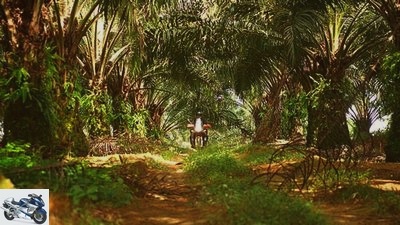
Scholz
to travel
On the way: Malaysia round trip
On the way: Malaysia round trip
Welcome to the jungle
Friendly people, streets with little traffic, unspoilt jungle, wild fruits, boundless beaches, pulsating cities, ancient tradition and hip modernity were discovered by the author Anton Scholz on his journey through the motorcycle paradise of Malaysia.
11/21/2008
Turquoise blue ocean stretches to infinity. Above it a clear blue sky. A look in the rear-view mirror shows another scenario: huge thunderclouds, flashing lightning. The thunder crashes in an infernal way. Nate and I can feel the tropical downpours on our necks and flee over the bridge from the island of Penang to the mainland. We are in Malaysia, a country with wild, largely untouched nature, bold construction projects and an exotic mix of Malaysian, Indian and Chinese cultural elements. All of this fits into a harmonious whole. Between the classic tourist destinations of Singapore and Thailand, Malaysia offers the world’s oldest jungle as well as Kuala Lumpur, one of the most progressive cities in Asia. We want to find out whether the stories of breathtaking winding roads through jungle-covered mountains and along endless white sandy beaches are true.
First we cross the town of Butterworth and drive north towards Baling, a town near the border with Thailand. Along the street I keep discovering old buildings from the colonial era, many of them neglected despite their beauty and half overgrown by the jungle. Unbridled botany oozes out between the artistic stucco and the playful bay windows of the houses. The buildings are slowly falling apart.
Every few hundred meters small stalls appear along the way selling fresh fruit and vegetables. Malaysia is a Garden of Eden: it is perpetual summer and some fruit is always just ripe. At the moment it is durian season: the sweetish, putrid smell of these large, prickly fruits inevitably rises in the nose. On previous trips to Asia, I learned to appreciate exotic fruits such as mangosteen, jackfruit and rambutan, but I was able to buy durian
never inspire. For Nate, however, durian is something new, and when I tell him that the fruit is considered a powerful aphrodisiac, he wants to try it. However, the pungent smell when opened causes my friend’s appetite to shrink drastically, and he gives up quickly.
The roads are well developed so that we can make rapid progress. Near Baling we turn off just before one of the border crossings to southern Thailand and drive along the border to the east, on the highway that connects the west and east coast of Malaysia. Although it is one of the main roads in the country that crosses the mountains of the peninsula, there is practically no traffic. On a stretch of over 100 kilometers, the most wonderful curves meander on well-paved asphalt strip without a single traffic light. Impenetrable jungle looms on both sides of the road, and the occasional wild screams of birds or monkeys, which can still live undisturbed here, deep inland. Almost dizzy from cornering, we reach Kota Bharu in the evening, a port city on the South China Sea and today’s destination.
Buy complete article

On the way: Malaysia round trip
Welcome to the jungle
8 pages) as PDF
€ 2.00
Buy now
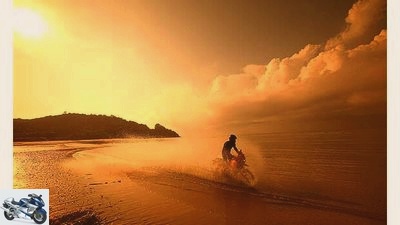
Scholz
Screams of wild animals from the jungle, endless sandy beaches, not a soul far and wide.
The next day we roll south on small roads along the east coast. It doesn’t take long for the first palm-strewn beaches to appear in front of us, which, to our surprise, seem completely deserted. Unimaginable in Europe, there you would hardly see the sand for all the people and deck chairs. While we could lie here all day under palm trees and swim in the sea without meeting a soul.
After a while along the coast, we pan inland towards Lake Kenyir, the largest man-made lake in Southeast Asia. As soon as we have left the coastal road, all human civilization seems to end: the villages are becoming rarer, and the huge palm oil plantations that stretch to the horizon to the left and right of the road are a reminder that we are not completely in the middle of nowhere. Palm oil plantations are a classic picture in Malaysia: The country is the world’s largest palm oil producer.
When we finally reach the lake, which opens up like a blue oasis in the middle of the green of the jungle, the feeling of greatest seclusion intensifies. Even the hotel is completely empty except for us and a young French family. Monkeys hang in the trees, exotic flowers give off bewitching scents, an iguana over a meter long crawls quietly across the footpath in front of me. To round off the picture, a palm-sized spider sits lurking over my bed. We actually landed in the middle of the jungle.
In bright sunshine we enjoy our breakfast the next morning with a view of the breathtakingly beautiful lake. The palm trees sway in a gentle breeze, I sip my freshly squeezed fruit juice and lean back. This is how life can be endured.
The next day, on the other hand, will be tough, as we have to cross the entire peninsula in great heat to get to Melakka, once the cultural and economic center of Malaysia. When we finally reach the city in the late afternoon, we take a break in the historic market square and soak up the history that surrounds us. For many centuries the place was one of the largest centers of Southeast Asia trade for the Portuguese, Dutch and British. The first to come to Melakka in 1509 were the Portuguese, and even then they found a bustling city where the Chinese traded with Malays and Indians. In the middle of the 17th century, the Dutch drove the Portuguese out and ruled for 150 years. The British finally took over in the early 19th century, and Stamford Raffles, the founder of Singapore, ensured that Melakka retained European elements. It so happens that the city today reflects the legacy of three European and three Asian cultures.
In the evening, Nate and I stroll through the atmospheric Chinatown, which looks like nothing has changed here in the last few centuries. Tomorrow we will be in Kuala Lumpur, where skyscrapers made of glass and steel shape the cityscape. Similar to so many Asian metropolises, the day before yesterday and the day after tomorrow are very close to one another in Malaysia.
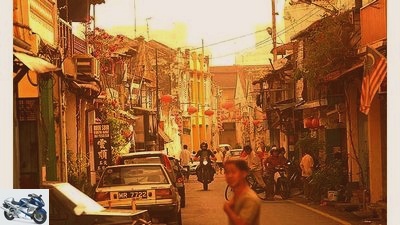
Scholz
Lively: the hustle and bustle in Melakka’s Chinatown. The city was once the cultural and economic center of Malaysia.
When I set off in the morning, there was an unpleasant surprise: my KTM 950 Adventure won’t start. The rattle of the starter indicates a battery problem and we have no choice but to push the motorcycle to the nearest small bike shop. The owner of the shop is amazed when I park the KTM in front of his shop. It takes some persuasion before the man is ready to try his luck. “A problem with the starter relay”, he says after half an hour screwing and pointing to a scrap-ripe Malaysian scooter. “I can remove a relay from the scooter there and screw it in here.” We skeptically give the okay and use the rest of the day to explore the historic city further. We discover old tombstones of European sailors who have found their final resting place in Melakka. In the hope that my adventure will be spared this fate, we return to the little shop. Lo and behold: she is alive! So it can go on.
Now that we have lost time, we take the autobahn. After only two hours we reach the first foothills of Kuala Lumpur. The huge Petronas twin towers can be seen from afar, which for a long time were the tallest building in the world and which dominate the cityscape.
Nowhere is the mix of cultures clearer than in Malaysia’s lively capital. Mosques stand next to Hindu temples and Chinese shrines. It is fun to try the various truly exotic foods and to haggle over prices for souvenirs with the vendors.
After two days of lively city life, head north along the west coast. I had heard good things about the endless tea fields and winding roads that lead to the Cameron Highlands. And it’s true: an endless series of curves winds its way up the mountains almost dizzyingly and offers wonderful views far over the country. We zoom on, kilometer after kilometer, as if in a frenzy. I realize too late that my tank is almost empty. But there isn’t even a village where you can buy gasoline. And so I can only hope that I don’t have to push the last few kilometers uphill. With the last drop of gasoline in the tank, we reach the Cameron Highlands. An almost indescribable panorama spreads before us: Lush green rows of tea fields cover the mountains as far as the eye can see. Individual clouds waft over the fields and give the whole thing a mystical atmosphere. Nate and I pause, knowing that this is the grand finale of our trip. A good 2,000 kilometers in Malaysia are already behind us, but we agree without a word: If it were up to us, we would love to add another 2,000 kilometers.
Info
A trip through Malaysia is fascinating because of its enormous diversity and exoticism. The traffic is smoother than in India or Vietnam, larger rental motorcycles are unfortunately rare.
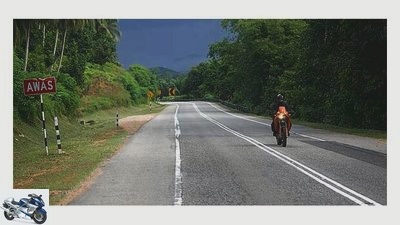
Scholz
Explosively growing flora everywhere, rapid road through pristine jungle on the way to Kota Bharu.
General / arrival
Malaysia consists of the Malaysia Peninsula and the northern part of Borneo Island. Malay, Chinese, Indian, Pakistani and other ethnic groups live in the country. English is widely spoken. Malaysia is a moderately Muslim country, which can be reached by air via Kuala Lumpur (flights around 800 euros). Entry by land is possible from Singapore or Thailand. EU nationals do not need a visa, but a passport that is valid for at least six months.
Climate and travel time
In Malaysia you can travel all year round, the temperatures are high. Warmer clothing is only recommended for the Cameron Highlands. The rainy season is from October to April, but there is also precipitation outside of this time. A tour in the Muslim fasting month of Ramadan (September) is not a problem.
accommodation
Malaysia is developed for tourism and offers a selection of accommodation in many cities. If you want to visit Lake Kenyir, the Lake Kenyir Resort (www.lakekenyir.com) is a luxurious base for around 80 euros per night. In Melakka you should choose a place to sleep in Chinatown like the Hotel Puri (www.hotelpuri.com, from around 26 euros per night). For Kuala Lumpur the Swiss-Inn (www.swissgarden.com, approx. 60 euros per night), in the Cameron Highlands the Lakehouse (www.lakehouse-cameron.com, strongly changing offers) is recommended.
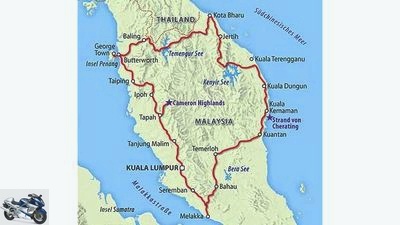
Map: Maucher / Mairdumont
Duration of the trip: 12 days; Distance covered: 2000 kilometers.
Safety and health
Malaysia is considered safe, but local customs should be respected. In mosques, respectful behavior is indicated, women should not show too much skin. You can eat in restaurants without hesitation, while the hygiene standards in the roadside food stalls are not always sufficient. Drink bottled water only.
Literature / information
Stefan Loose Travel Manual Malaysia (23.95 euros), Malaysia & Singapore by Dorling Kindersley travel guide publisher (22.79 euros). Maps: NELLES MAP Malaysia West (1: 1500000, 7.90 euros). The Malaysia map by Reise Know-How on a scale of 1: 800,000 (17.90 euros) is more detailed. Further information: www.tourismmalaysia.de, www.virtualmalaysia.com, www.malaysia-tourismus.de, de.wikipedia.org/wiki/Malaysia.
Motorbike rental
Regular motorcycle rental companies are not easy to find. The local KTM importer Planet Cycle (www.planetcycle.com.my) organized two rental machines for this report. Another option is buying and then selling or transporting your own bike to Malaysia. Information on the subject of motorcycle shipping can be found at the Motorrad Karawane (www.motorradkarawane.de) or Horizons Unlimited (www.horizonsunlimited.com).
Related articles
-
Jorg Lohse 43 pictures Jorg Lohse 1/43 … and into the kilometer-wide river bed of the Kali Gandaki. Jorg Lohse 2/43 One-a-pit stop at Ramesh (left) and…
-
Motorcycle trip to the Ore Mountains for the 2500th edition of MOTORRAD
Breakable 33 pictures Breakable 1/33 The motorcycle expedition through the Ore Mountains. The leitmotif is the number 2500 – for the MOTORRAD…
-
Dentges 18th pictures Dentges 1/18 Malaysia, capital: Kuala Lumpur; Area: 330290 km²; Foundation: 1957; Currency: Ringgit; Population: 28 million….
-
Autumn trip MOTORCYCLE long-term tester
Artist motorcycles Autumn trip MOTORCYCLE long-term testers The MOTORRAD long-term testers on an autumn ride Slovenia! The traditional autumn ride takes…
-
Motorcycle trip in the Pyrenees
shepherd 33 pictures shepherd 1/33 Motorcycle trip in the Pyrenees – From the Mediterranean to the Atlantic. shepherd 2/33 Air sovereignty: Giant…
-
Motorcycle trip through Mexico
Jo Deleker 34 pictures Jo Deleker 1/34 Out and about in Mexico. Jo Deleker 2/34 There aren’t that many in Mexico anymore, so everyone has to be in the…
-
Round trip: by motorcycle through Turkey
Daams 23 pictures Daams 1/23 With Mehmet Colak, called Mokka, we went on a tour from Viersen to Istanbul and then across Turkey. Mocha we get to know…
-
Motorcycle trip – Norway in summer
Joachim Deleker to travel Motorcycle trip – Norway in summer Motorcycle trip – Norway in summer Weatherproof Norway in summer, time of light, time for a…
-
On the way: Readers’ trip to the Carpathians
Kaitinnis 10 pictures Kaitinnis 1/10 The magnificently decorated Sucevita Monastery. Kaitinnis 2/10 A local Hutsul in festival costume. Kaitinnis 3/10…
-
Motorcycle trip to the Sierra Nevada (Spain)
Daams Klaus H. 12th pictures Daams Klaus H. 1/12 In the highest mountains of the Iberian Peninsula, the sky is quite close, and the built-up Costa del…